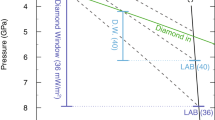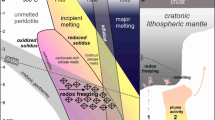Abstract
Plate tectonics plays a vital role in the evolution of our planet. Geochemical analysis of Earth’s oldest continental crust suggests that subduction may have begun episodically about 3.8 to 3.2 billion years ago, during the early Archaean or perhaps more than 3.8 billion years ago, during the Hadean. Yet, mantle rocks record evidence for modern-style plate tectonics beginning only in the late Archaean, about 3 billion years ago. Here we analyse the nitrogen abundance, as well as the nitrogen and carbon isotopic signatures of Archaean placer diamonds from the Kaapvaal craton, South Africa, which formed in the upper mantle 3.1 to 3.5 billion years ago. We find that the diamonds have enriched nitrogen contents and isotopic compositions compared with typical mantle values. This nitrogen geochemical fingerprint could have been caused by contamination of the mantle by nitrogen-rich Archaean sediments. Furthermore, the carbon isotopic signature suggests that the diamonds formed by reduction of an oxidized fluid or melt. Assuming that the Archaean mantle was more reduced than the modern mantle, we argue that the oxidized components were introduced to the mantle by crustal recycling at subduction zones. We conclude, on the basis of evidence from mantle-derived diamonds, that modern-style plate tectonics operated as early as 3.5 billion years ago.
This is a preview of subscription content, access via your institution
Access options
Subscribe to this journal
Receive 12 print issues and online access
$259.00 per year
only $21.58 per issue
Buy this article
- Purchase on Springer Link
- Instant access to full article PDF
Prices may be subject to local taxes which are calculated during checkout



Similar content being viewed by others
References
Condie, K. C. & Pease, V. in When Did Plate Tectonics Begin on Planet Earth? v–viii (The Geological Society of America, 2008).
Foley, S. F. A reappraisal of redox melting in the Earth’s Mantle as a function of tectonic setting and time. J. Petrol. 52, 1363–1391 (2011).
Shirey, S. B., Kamber, B. S., Whitehouse, M. J., Mueller, P. A. & Basu, A. R. A Review of the Isotopic and Trace Element Evidence for Mantle and Crustal Processes in the Hadean and Archean: implications for the Onset of Plate Tectonic Subduction GSA Special Papers 440, 1–29, (2008).
Næraa, T. et al. Hafnium isotope evidence for a transition in the dynamics of continental growth 3.2 Gyr ago. Nature 485, 627–630 (2012).
Furnes, H., de Wit, M. J., Staudigel, H., Rosing, M. & Muehlenbachs, K. A vestige of Earth’s oldest ophiolite. Science 315, 1704–1707 (2007).
O’Neil, J., Francis, D. & Carlson, R. W. Implications of the Nuvvuagittuq greenstone belt for the formation of Earth’s early crust. J. Petrol. 52, 985–1009 (2011).
Shirey, S. B. & Richardson, S. H. Start of the Wilson cycle at 3 Ga shown by diamonds from subcontinental mantle. Science 333, 434–436 (2011).
Shirey, S. B. et al. Diamonds and the geology of mantle carbon. Rev. Mineral. Geochem. 75, 355–421 (2013).
Pearson, D. G. et al. Hydrous mantle transition zone indicated by ringwoodite included within diamond. Nature 507, 221–224 (2014).
Cartigny, P., Palot, M., Thomassot, E. & Harris, J. W. Diamond formation: a stable isotope perspective. Annu. Rev. Earth Planet. Sci. 42, 699–732 (2014).
Richardson, S. H., Gurney, J. J., Erlank, A. J. & Harris, J. Origin of diamonds in old enriched mantle. Nature 310, 198–202 (1984).
Westerlund, K. J. et al. A subduction wedge origin for Paleoarchean peridotitic diamonds and harzburgites from the Panda kimberlite, Slave craton: evidence from Re–Os isotope systematics. Contrib. Mineral. Petrol. 152, 275–294 (2006).
Stachel, T., Banas, A., Muehlenbachs, K., Kurszlaukis, S. & Walker, E. C. Archean diamonds from Wawa (Canada): samples from deep cratonic roots predating cratonization of the Superior Province. Contrib. Mineral. Petrol. 151, 737–750 (2006).
Stachel, T. & Harris, J. W. The origin of cratonic diamonds—Constraints from mineral inclusions. Ore Geol. Rev. 34, 5–32 (2008).
Palot, M., Cartigny, P., Harris, J. W., Kaminsky, F. V. & Stachel, T. Evidence for deep mantle convection and primordial heterogeneity from nitrogen and carbon stable isotopes in diamond. Earth Planet. Sci. Lett. 357–358, 179–193 (2012).
Shilobreeva, S., Martinez, I., Busigny, V., Agrinier, P. & Laverne, C. Insights into C and H storage in the altered oceanic crust: results from ODP/IODP Hole 1256D. Geochim. Cosmochim. Acta 75, 2237–2255 (2011).
Marty, B., Alexander, C. M. O. & Raymond, S. N. Primordial origins of Earth’s carbon. Rev. Mineral. Geochem. 75, 149–181 (2013).
Stachel, T., Harris, J. W. & Muehlenbachs, K. Sources of carbon in inclusion bearing diamonds. Lithos 112, 625–637 (2009).
Cartigny, P. & Marty, B. Nitrogen isotopes and mantle geodynamics: the emergence of life and the atmosphere-crust-mantle connection. Elements 9, 359–366 (2013).
Thomazo, C. & Papineau, D. Biogeochemical cycling of nitrogen on the early Earth. Elements 9, 345–351 (2013).
Davies, G. F. Punctuated tectonic evolution of the Earth. Earth Planet. Sci. Lett. 136, 363–379 (1995).
Thomassot, E., Cartigny, P., Harris, J. W. & Viljoen, K. S. F. Methane-related diamond crystallization in the Earth’s mantle: stable isotope evidences from a single diamond-bearing xenolith. Earth Planet. Sci. Lett. 257, 362–371 (2007).
Palot, M., Pearson, D. G., Stern, R. A., Stachel, T. & Harris, J. W. Isotopic constraints on the nature and circulation of deep mantle C–H–O–N fluids: carbon and nitrogen systematics within ultra-deep diamonds from Kankan (Guinea). Geochim. Cosmochim. Acta 139, 26–46 (2014).
Petts, D. C., Chacko, T., T, S., Stern, R. A. & Heaman, L. M. A nitrogen isotope fractionation factor between diamond and its parental fluid derived from detailed SIMS analysis of a gem diamond and theoretical calculations. Chem. Geol. 410, 188–200 (2015).
Cartigny, P., Harris, J. W. & Javoy, M. in The J.B. Dawson Volume: Proceedings of the VIIth International Kimberlite Conference Vol. 1 (eds Gurney, J. J., Gurney, J. L., Pascoe, M. D. & Richardson, S. H.) 117–124 (Red Roof Design, 1999).
Busigny, V. & Bebout, G. E. Nitrogen in the silicate Earth: speciation and isotopic behavior during mineral-fluid interactions. Elements 9, 353–358 (2013).
Bebout, G. E. & Fogel, M. L. Nitrogen-isotope compositions of metasedimentary rocks in the Catalina Schist, California: implications for metamorphic devolatilization history. Geochim. Cosmochim. Acta 56, 2839–2849 (1992).
Watenphul, A., Wunder, B. & Heinrich, W. High-pressure ammonium-bearing silicates: implications for nitrogen and hydrogen storage in the Earth’s mantle. Am. Mineral. 94, 283–292 (2009).
Moyen, J.-F., Stevens, G. & Kisters, A. Record of mid-Archaean subduction from metamorphism in the Barberton terrain, South Africa. Nature 442, 559–562 (2006).
Halama, R., Bebout, G. E., John, T. & Schenk, V. Nitrogen recycling in subducted oceanic lithosphere: the record in high- and ultrahigh-pressure metabasaltic rocks. Geochim. Cosmochim. Acta 74, 1636–1652 (2010).
Kesson, S. E. & Ringwood, A. E. Slab-mantle interactions: 2. The formation of diamonds. Chem. Geol. 78, 97–118 (1989).
Deines, P. The carbon isotopic composition of diamonds: relationship to diamond shape, color, occurrence and vapor composition. Geochim. Cosmochim. Acta 44, 943–961 (1980).
Frost, D. J. & McCammon, C. A. The redox state of Earth’s mantle. Annu. Rev. Earth Planet. Sci. 36, 389–420 (2008).
Evans, K. A. The redox budget of subduction zones. Earth-Sci. Rev. 113, 11–32 (2012).
Aulbach, S., Stachel, T., Viljoen, S. K., Brey, G. P. & Harris, J. W. Eclogitic and websteritic diamond sources beneath the Limpopo Belt—is slab-melting the link? Contrib. Mineral. Petrol. 143, 56–70 (2002).
Luth, R. W. & Stachel, T. The buffering capacity of lithospheric mantle: implications for diamond formation. Contrib. Mineral. Petrol. 168, 1083 (2014).
O’Neill, C. & Wyman, D. A. in Archean Geodynamics and Environments Vol. 164 (eds Benn, K., Mareschal, J.-C. & Condie, K.C.) 177–188 (American Geophysical Union, 2006).
Shirey, S. B., Richardson, S. H. & Harris, J. W. Integrated models of diamond formation and craton evolution. Lithos 77, 923–944 (2004).
de Wit, M. J. et al. Formation of an Archaean continent. Nature 357, 553–562 (1992).
Poujol, M., Robb, L. J., Anhaeusser, C. R. & Gericke, B. A review of the geochronological constraints on the evolution of the Kaapvaal Craton, South Africa. Precambrian Res. 127, 181–213 (2003).
Tappe, S., Kjarsgaard, B. A., Kurszlaukis, S., Nowell, G. M. & Phillips, D. Petrology and Nd-Hf isotope geochemistry of the Neoproterozoic Amon Kimberlite Sills, Baffin Island (Canada): evidence for deep mantle magmatic activity linked to supercontinent cycles. J. Petrol. 55, 2003–2042 (2014).
Zeh, A., Stern, R. A. & Gerdes, A. The oldest zircons of Africa-Their U-Pb-Hf-O isotope and trace element systematics, and implications for Hadean to Archean crust-mantle evolution. Precambrian Res. 241, 203–230 (2014).
Boyd, S. R., Kiflawi, I. & Woods, G. S. Infrared absorption by the B nitrogen aggregate in diamond. Philos. Mag. B 72, 351–361 (1995).
Boyd, S. R., Kiflawi, I. & Woods, G. S. The relationship between infrared absorption and the A defect concentration in diamond. Philos. Mag. B 69, 1149–1153 (1994).
Stachel, T., Harris, J. W., Tappert, R. & Brey, G. P. Peridotitic diamonds from the Slave and the Kaapvaal cratons—similarities and differences based on a preliminary data set. Lithos 71, 489–503 (2003).
Stern, R. A. et al. Methods and Reference Materials for SIMS Diamond C- and N-isotope Analysis (Canadian Centre for Isotopic Microanalysis, 2014).
Acknowledgements
We thank K. James and D. White at Museum Africa Johannesburg for access to the historical diamond collection; R. Gibson and B. Cairncross for facilitating the loan of the specimens; S. Connell and T. Mashepo for diamond sectioning; L. Blackwell for the assistance with the diamond imaging. We thank T. Stachel for use of the De Beers Diamond Laboratory at the University of Alberta and informative discussion. We thank C. Skinner of De Beers Exploration for sponsorship of this project. K.A.S. and S.T. acknowledge support from the CIMERA NRF-DST Centre of Excellence at the University of Johannesburg.
Author information
Authors and Affiliations
Contributions
K.A.S. and S.T. conceived the model and prepared the initial manuscript. R.A.S. carried out the SIMS carbon and nitrogen isotope, as well as nitrogen concentration analyses. K.A.S. conducted FTIR nitrogen analyses. All authors contributed to preparation of the final manuscript.
Corresponding author
Ethics declarations
Competing interests
The authors declare no competing financial interests.
Supplementary information
Supplementary Information
Supplementary Information (PDF 14526 kb)
Rights and permissions
About this article
Cite this article
Smart, K., Tappe, S., Stern, R. et al. Early Archaean tectonics and mantle redox recorded in Witwatersrand diamonds. Nature Geosci 9, 255–259 (2016). https://doi.org/10.1038/ngeo2628
Received:
Accepted:
Published:
Issue Date:
DOI: https://doi.org/10.1038/ngeo2628
This article is cited by
-
Light oxygen isotopic composition in deep mantle reveals oceanic crust subduction before 3.3 billion years ago
Communications Earth & Environment (2024)
-
An underexploited invisible gold resource in the Archean sulphides of the Witwatersrand tailings dumps
Scientific Reports (2023)
-
Redox state of the Dharwar craton root as inferred from eclogite and peridotite sourced mantle cargo, with implications for kimberlite and lamproite magma formation
Contributions to Mineralogy and Petrology (2023)
-
Plate tectonics in the twenty-first century
Science China Earth Sciences (2023)
-
Oxidation of Archean upper mantle caused by crustal recycling
Nature Communications (2022)



